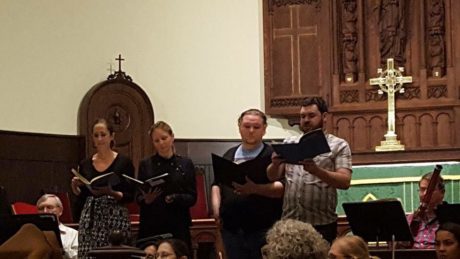The Annapolis Chorale and Annapolis Chamber Orchestra’s performance of Mozart’s Requiem, presented by Live Arts Maryland, was a well-performed clever combination of old and new pieces. Before performing the famous classical choral work, they also presented two other compositions, Ola Gjeilo’s Dark Night of the Soul, from 2010, and Francis Poulenc’s Organ Concerto in G minor, from the late 193’s. Beautiful singing and playing combined to create a night of powerful music, in a historic church with excellent musical acoustics and a creative use of space.
Ernest Green was the Music Director and Conductor for the performance. Before each piece began, he explained a little about its history and background, as well as elements to pay particular attention to. This was especially helpful for Dark Night, being so recent that few in the audience had probably heard it before. Based on three stanzas of a poem of the same name by St. John of the Cross, a medieval poet, Green described the work as “a spiritual journey.” Composed of piano, violins, cello, and voice, it is a perfect way to begin the program. Moving and evocative, it is almost a duet between piano and choir.
Gjeilo wrote in his program notes that, “often the piano is accompanying the choir, but sometimes the choir is accompanying the piano.” This certainly comes through in the performance. Starting off fast, the piano, played wonderfully by Joseph Satava, sounds very rhythmic, almost jazz-like, with the choir joining in for energetic quickness. After that, the piano slows down considerably, the other strings softly accompanying it before the choir continues, producing a quiet, contemplative, almost mystical feeling. The piece has another moment of fast, rhythmic playing, before ending on a quiet, slow moment. The work is simple yet beautiful and evocative, a modern take on spirituality.

Green describes Poulenc’s Organ Concerto as a dialogue of sorts between the organ and the orchestra, and that is indeed the case in this performance. Sometimes the organ plays separately from the orchestra, allowing the other instruments to respond, while at other times it blends right in with the group. Larry Molinaro plays the organ wonderfully from heavy, Gothic-like flourishes to light, airy stretches – almost reminiscent of a circus calliope. The piece starts dramatically, with a rich, deep sound from the organ as the orchestra responds in kind. Then, the orchestra plays light and fanciful. At times the organ punctuates the orchestra in short bursts. In one section, the organ drones on for a while, insistently and passionately. Towards the end, timpani drums accompany the organ, bringing the piece to a powerful, highly dramatic conclusion. Although it may feel somewhat unusual compared to the other works on the program, especially as an all-instrumental piece, it serves as a nice transition between the new and the old, as well as a chance to show off the diverse talents of the performers.
The highlight of the evening, of course,was the Requiem Mass in D minor. Green explained that since Mozart died before completing the piece, several others had worked to finish it. Franz Xaver Sussmayr completed the version used for this night, which Green believes is closest to what Mozart would have done. The chorale and orchestra perform it beautifully, with voices and instruments blending together to create a rich, harmonious sound, full of passion and drama.
The four soloists were superb, singing separately and together, filling the church with their vocal power and beauty. Soprano Jessica Satava was light and lovely, her voice carrying the power of the words. Mezzo-Soprano Catrin Davies was elegant and gentle, giving a gentle air. Tenor Justin Gonzalez had a highly expressive voice, conveying emotion seemingly without effort. Baritone Jeffrey Gates had a deep, rich sound, full of gravity and importance.
“Lacrimosa,” while being one of the most famous sections, is also in this performance one of the most beautiful. The chorale perfectly captured the dramatic, sorrowful opening before transitioning to the softer, gentler measure. The orchestra and chorale also perform the “Benedictus” section with a joyful sound. They carried the dramatic rises and softer falls of “Agnus Dei.” The final section – “Communio” – has a deeply moving and satisfying ending. Each section of the Requiem could stand on its own; together, they form a powerful, dramatic piece of music.
The placement of singers and players deserves mentioning, as they change with each work. For Dark Night of the Soul, a few orchestra members and chorale members gathered near the church’s entrance, with a piano to their left. For the Organ Concerto, the whole orchestra was placed by the altar, while the organ was played in the balcony above the entrance. For the Requiem, the orchestra remained by the altar, and the entire chorale filled the space behind them, with the soloists sitting in front. It is a testament to the organizers’ skills that both groups could setup and reorganize themselves so quickly and easily; it took less than five minutes to transition between each piece.
The setting is absolutely perfect. St. Anne’s Episcopal Church is a stunning place for a concert like this. One small quibble: a microphone would have made Green’s voice clearer when he discussed the pieces. Otherwise, everything comes together to create an enchanting evening, combining different time periods, instruments, and voices in creative, sometimes unexpected, ways.
Running Time: Approximately two hours.
Mozart’s Requiem played on October 28 and 29, 2016, at St. Anne’s Episcopal Church – Church Circle in Annapolis, MD. For information about more Live Arts Maryland events, and to purchase tickets, call (410) 280-5640, or go online.





